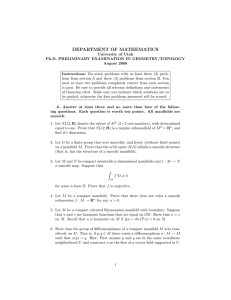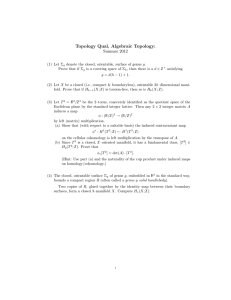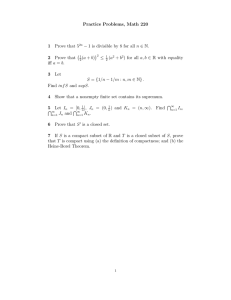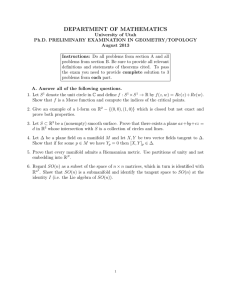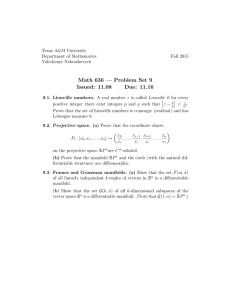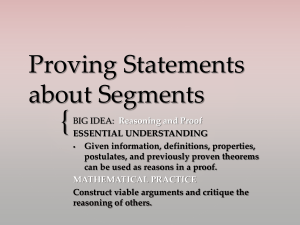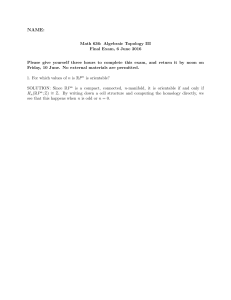DEPARTMENT OF MATHEMATICS
advertisement
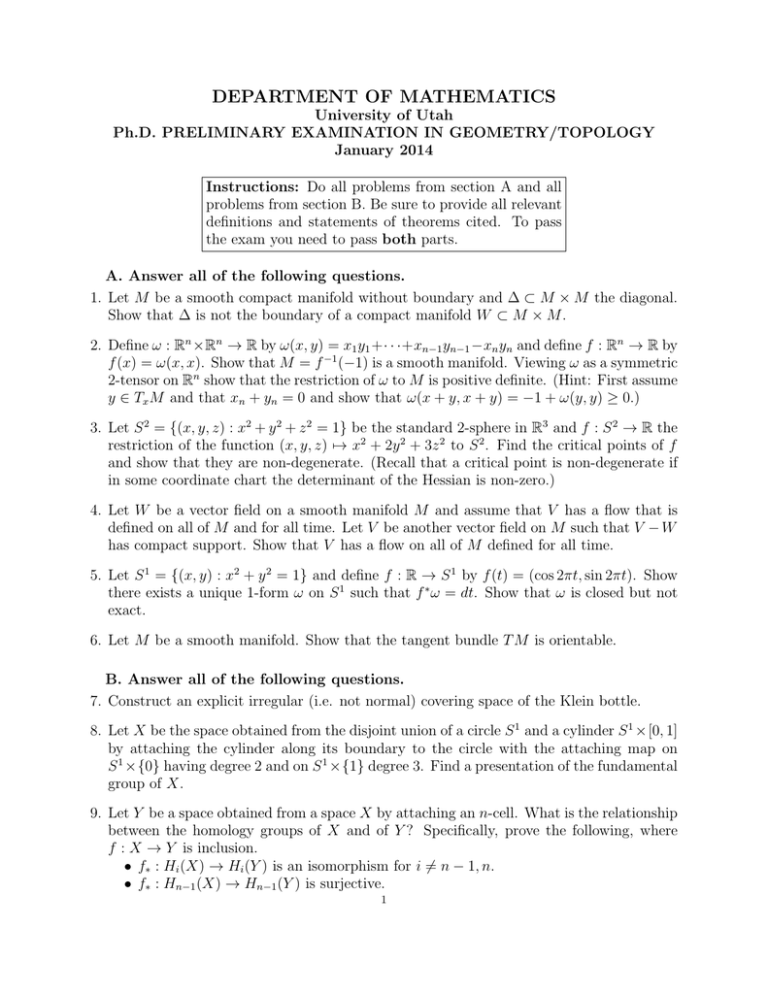
DEPARTMENT OF MATHEMATICS
University of Utah
Ph.D. PRELIMINARY EXAMINATION IN GEOMETRY/TOPOLOGY
January 2014
Instructions: Do all problems from section A and all
problems from section B. Be sure to provide all relevant
definitions and statements of theorems cited. To pass
the exam you need to pass both parts.
A. Answer all of the following questions.
1. Let M be a smooth compact manifold without boundary and ∆ ⊂ M × M the diagonal.
Show that ∆ is not the boundary of a compact manifold W ⊂ M × M .
2. Define ω : Rn ×Rn → R by ω(x, y) = x1 y1 +· · ·+xn−1 yn−1 −xn yn and define f : Rn → R by
f (x) = ω(x, x). Show that M = f −1 (−1) is a smooth manifold. Viewing ω as a symmetric
2-tensor on Rn show that the restriction of ω to M is positive definite. (Hint: First assume
y ∈ Tx M and that xn + yn = 0 and show that ω(x + y, x + y) = −1 + ω(y, y) ≥ 0.)
3. Let S 2 = {(x, y, z) : x2 + y 2 + z 2 = 1} be the standard 2-sphere in R3 and f : S 2 → R the
restriction of the function (x, y, z) 7→ x2 + 2y 2 + 3z 2 to S 2 . Find the critical points of f
and show that they are non-degenerate. (Recall that a critical point is non-degenerate if
in some coordinate chart the determinant of the Hessian is non-zero.)
4. Let W be a vector field on a smooth manifold M and assume that V has a flow that is
defined on all of M and for all time. Let V be another vector field on M such that V − W
has compact support. Show that V has a flow on all of M defined for all time.
5. Let S 1 = {(x, y) : x2 + y 2 = 1} and define f : R → S 1 by f (t) = (cos 2πt, sin 2πt). Show
there exists a unique 1-form ω on S 1 such that f ∗ ω = dt. Show that ω is closed but not
exact.
6. Let M be a smooth manifold. Show that the tangent bundle T M is orientable.
B. Answer all of the following questions.
7. Construct an explicit irregular (i.e. not normal) covering space of the Klein bottle.
8. Let X be the space obtained from the disjoint union of a circle S 1 and a cylinder S 1 ×[0, 1]
by attaching the cylinder along its boundary to the circle with the attaching map on
S 1 ×{0} having degree 2 and on S 1 ×{1} degree 3. Find a presentation of the fundamental
group of X.
9. Let Y be a space obtained from a space X by attaching an n-cell. What is the relationship
between the homology groups of X and of Y ? Specifically, prove the following, where
f : X → Y is inclusion.
• f∗ : Hi (X) → Hi (Y ) is an isomorphism for i 6= n − 1, n.
• f∗ : Hn−1 (X) → Hn−1 (Y ) is surjective.
1
• f∗ : Hn (X) → Hn (Y ) is injective.
• Either f∗ : Hn−1 (X) → Hn−1 (Y ) has finite kernel or f∗ : Hn (X) → Hn (Y ) is an
isomorphism (but not both).
Assuming the ranks of Hn−1 (X) and Hn (X) are finite, also prove that
rank (Hn (X)) − rank (Hn−1 (X)) = rank (Hn (Y )) − rank (Hn−1 (Y )) − 1
10. Let p : X̃ → X be an n-sheeted covering map between two connected, locally pathconnected spaces. Let C∗ (X) and C∗ (X̃) denote the singular chain complexes of X and
X̃ respectively.
(a) Give a definition of a chain morphism and prove that τ : C∗ (X) → C∗ (X̃) given by
n
X
τ (σ) =
σ̂i
i=1
is a chain morphism, where σ̂1 , · · · , σ̂n are the n lifts of σ to X̃, and σ is a singular
simplex in X.
(b) Prove that
p∗ : Hi (X̃; Q) → Hi (X; Q)
is always surjective. Hint: Consider the composition p∗ τ : C∗ (X) → C∗ (X).
(c) Find an example where
p∗ : Hi (X̃; Z) → Hi (X; Z)
is not surjective.
11. Prove that there is no map h : RP 3 → RP 2 that induces an isomorphism between
fundamental groups. Hint: use cup products with Z/2Z coefficients. State all theorems
you are using.
12. Let M be a connected compact 3-manifold (without boundary) and assume that H1 (M ) =
Z/3Z. Find H2 (M ). Carefully justify the answer, and state all theorems you are using.
2
